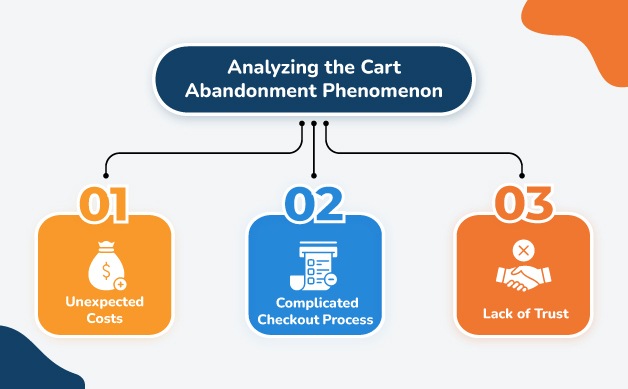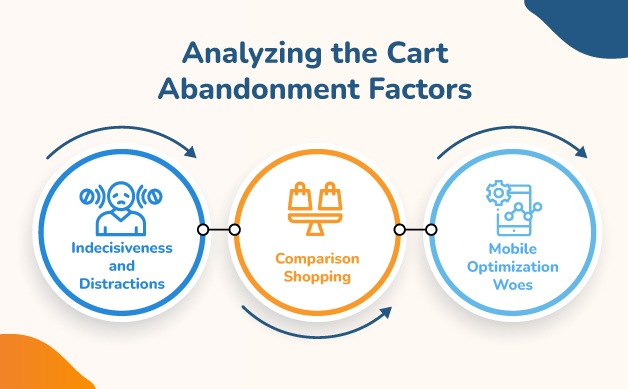Understanding Cart Abandonment and How to Recover
In the dynamic realm of e-commerce, cart abandonment is a significant challenge faced by e-commerce and D2C players. The journey from a shopper adfaced by e-commerce and D2C playerseting the purchase can be complex and riddled with hurdles. Cart abandonment causes frustration for businesses and leaves potential revenue on the table.
In this comprehensive blog, we will navigate the intricacies of cart abandonment, explore its journey, analyze its factors, and present effective recovery strategies.
What is Cart Abandonment?
Imagine you’re shopping online. You get excited when you find stuff you like and put them in your cart. But then, you hesitate. Maybe you see unexpected costs like shipping fees, or the checkout process is too long and confusing. These hesitations can lead to cart abandonment.
As you go through the checkout process, other things like distractions or technical problems can make you change your mind too. To reduce cart abandonment, businesses need to address the pain points and reduce abandonment rates.
Analyzing the Cart Abandonment Phenomenon
Delving deeper into the cart abandonment enigma requires meticulous analysis of the underlying factors. Cart abandonment analysis involves scrutinizing data to identify patterns, trends, and triggers contributing to this phenomenon.

- Unexpected Costs: Research by Baymard Institute suggests that unexpected additional costs, such as shipping fees or taxes, are among the leading causes of cart abandonment. Shoppers who initially find a product appealing might be discouraged by unforeseen expenses during checkout.
- Complicated Checkout Process: The complexity of the checkout process is a formidable adversary in the battle against cart abandonment. Lengthy and complicated checkout procedures frustrate users, leading them to abandon their carts.
- Lack of Trust: Trust is a cornerstone of e-commerce. When customers doubt their personal and financial information security, they are more likely to abandon their carts. A survey by eMarketer shows that 58% of shoppers abandon their carts due to security concerns.
Analyzing the Cart Abandonment Factors
To truly understand cart abandonment, we need to look at these factors. Each factor carries its weight in influencing consumer behavior.

Indecisiveness and Distractions
Imagine a shopper engrossed in cart-filling, only distracted by life’s myriad demands – a phone call, a crying child, or a pressing chore. This can lead to cart abandonment. Businesses can find ways to minimize these distractions.
Comparison Shopping
The digital shopper is empowered, with numerous options at their fingertips. People often shop around online. They might put things in their cart at one store but find a better deal elsewhere and leave.
Mobile Optimization Woes
Many folks use their phones for online shopping. If the mobile experience isn’t smooth – like slow loading or tricky forms – it can make people abandon their carts.
How to Recover from Cart Abandonment?
While understanding the causes of cart abandonment is vital, businesses must also equip themselves with practical strategies to recover these abandoned carts and encourage conversions.

Remarketing and Abandoned Cart Emails
Leveraging the power of remarketing and abandoned cart emails is a proven strategy.
Sending personalized emails reminding shoppers of their abandoned items is a good strategy. It can bring them back to finish their purchase.
Streamlined Checkout Process
Simplifying the checkout process can work wonders. Offering guest checkout options, minimizing form fields, and providing clear progress indicators can expedite the process and reduce friction.
Transparency in Costs
Displaying all costs upfront, including shipping fees and taxes, can mitigate the surprise factor and build customer trust.
Trust Signals
Incorporating trust signals such as security badges, customer reviews, and transparent privacy policies can alleviate concerns and enhance shoppers’ confidence in the transaction.
Real-Time Call Back
A real-time call back option can add a human touch to cart abandonment recovery. When customers abandon their cart, offering them the opportunity to receive a call from a customer service representative can address their concerns and provide personalized assistance, potentially leading to a successful conversion.
The Road Ahead: Cart Abandonment Recovery as a Continuous Process
Cart abandonment recovery is not a one-time effort but a continuous optimization process. Regularly analyzing cart abandonment data, experimenting with different recovery techniques, and adapting to changing consumer behavior are essential for sustained success.
As e-commerce evolves, businesses must stay attuned to the evolving landscape of cart abandonment. Technologies such as AI-driven chatbots, predictive analytics, and real-time call-back features can play a pivotal role in identifying real-time abandonment triggers and engaging with customers to address their concerns.
Conclusion: Embracing the Challenge of Cart Abandonment
In the complex world of e-commerce, where every click and hesitation matters, the issue of cart abandonment is more than a challenge—it’s an opportunity.
By traversing the intricate journey that customers embark upon, understanding the myriad factors that contribute to abandonment, and implementing thoughtful recovery strategies, businesses can reclaim potentially lost revenue and foster trust and loyalty among their audience.
As the digital landscape continues to evolve, so do the tactics at our disposal. Remember, addressing cart abandonment isn’t just a tactical endeavor; it’s a strategic commitment to crafting seamless experiences that resonate with customers and guide them toward conversion.
Through ongoing analysis, innovation, and a relentless customer-centric approach, businesses can navigate the complex cart abandonment conundrum and emerge more robust and better equipped to seize the endless possibilities that e-commerce holds.
In e-commerce, the journey from cart abandonment to recovery isn’t just a transactional path—it’s a transformative one, where persistence, adaptability, and a deep understanding of customer behavior pave the way for success.
Remember, the journey from cart abandonment to recovery is transformative, requiring persistence, adaptability, and a customer-centric approach.










